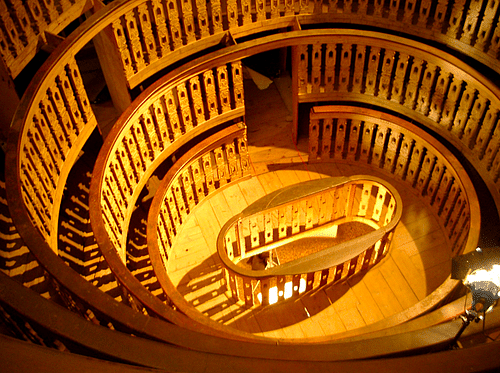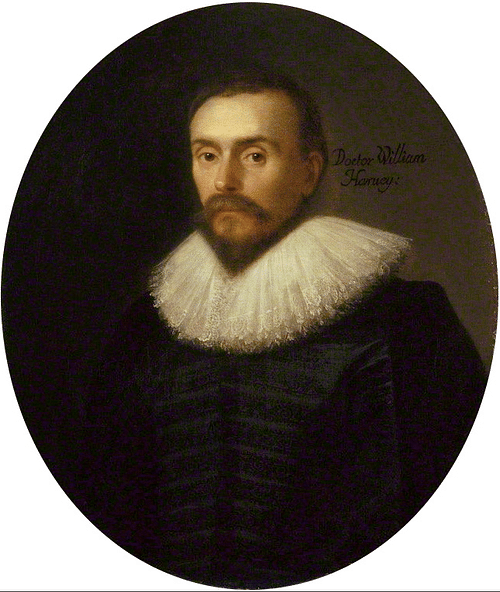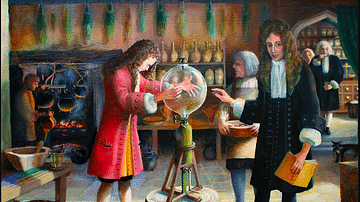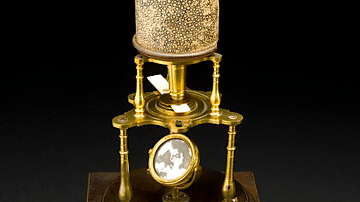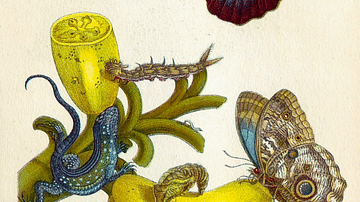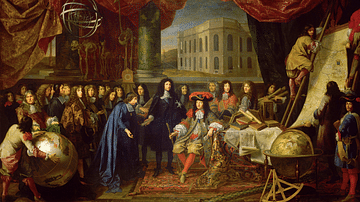The human body's system of blood circulation was discovered by the English physician and anatomist William Harvey (1578-1657) in 1628. Harvey determined the relationship between the blood system of arteries and veins and the regular contractions of the heart. The discovery, one of the most important in the Scientific Revolution, replaced the prevailing views on the blood system, which had been held since antiquity. Harvey's work inspired further studies of the circulatory system, particularly the connection with the lungs, while his method of using experimentation and evidence to support his theory became standard scientific practice.
An Eminent Physician
William Harvey was born in Folkestone in England on 1 April 1578, the son of a prosperous sheep farmer. William studied at the King's School in Canterbury and then at Gonville Caius College of the University of Cambridge, graduating in 1597. From 1600 to 1602, he studied medicine at the University of Padua in Italy, where, perhaps most significantly for Harvey's future research, the practice of vivisection was much more common than in England at the time. Harvey returned to England where, from 1609, he worked as a physician in Saint Bartholomew's Hospital in London. Harvey became so renowned he was appointed the physician to both King James I of England (r. 1603-1625) and Charles I of England (r. 1625-1649).
In an illustrious career, Harvey was made a fellow of the London College of Physicians in 1607. His interest and skill regarding anatomy are evidenced by his appointment in 1615 to the position of the college's Lumleian Lecturer in Anatomy and Surgery, a post held for life. The permanent lecturer role meant that Harvey carried out many demonstration dissections for students, surgeons, barbers, and anyone else who wished to attend the proceedings, which were held in a circular and chilled crucible known as the anatomical theatre. Harvey would carve with a scalpel in one hand and point out interesting anatomical titbits using a silver-tipped whalebone in the other. Harvey would often attempt to lift the sombre shroud that inevitably enveloped such bloody proceedings with dramatic gestures, colourful language, and occasional humour. Corpses for the dissections were acquired by fair means or foul. Hospitals and hangmen were the main sources of sufficiently fresh corpses, although those tasked with providing specimens were not averse to grave robbing and other nefarious means to satiate the appetite of the surgeon-lecturers.
An Age-old Mystery
The importance of blood to the human body has been known since antiquity when it was considered one of the four vital humours in the body. Still, blood was little understood both as to its purpose (except as a general carrier of 'nutrients') or its individual constituents. One thing that did become a common practice was to somehow relieve a patient's ailment by phlebotomy, that is, bloodletting. Relieving a patient of a copious amount of blood using all kinds of methods ranging from sharp instruments to leeches became a standard but rarely successful medical treatment that typically brought anything but relief to the hapless sufferer.
The physical evidence of the cardiovascular system was known in antiquity thanks to dissection and vivisection and particularly the studies of the Greek physician Galen (129-216 CE), who believed that blood (arterial being visibly redder than venous blood) passed through tiny pores from one side of the heart to the other. Galen seemed to hold a monopoly of knowledge on the matter until the investigative work of Harvey. There were some intermediaries in this journey of discovery, notably Leonardo da Vinci (1452-1519), who made private sketches of the cardiovascular system, and the Spanish scientist Michael Servetus (1511-1553), whose suggestion that blood passed through the lungs was noted in a lifetime's work full of heresies that contributed to him being burnt at the stake by the Christian Church. Still then, the exact connection between the heart, lungs, and blood remained obscure. The major problem was that a living, beating heart could not then be seen and studied (or could be seen working only for a few seconds during vivisection). Practical inquiry had to be combined with theoretical hypotheses.
In Italy, certain thinkers were getting closer to the problem of how the blood system really worked. Andrea Cesalpino (1524-1603) suggested that blood continuously went through the lungs and coined this process 'circulation'. Another important Italian biologist was Hieronymus Fabricius of Aquapendente (1533-1619), who, influenced by the approach of Aristotle (384-322 BCE), whose work was just then regaining scholarly interest, took to examining all species, not just those similar to humans. Fabricius added to the current body of knowledge observation of valves (what he called 'little doors') which controlled the blood flow in blood vessels and so prevented the legs from becoming oversupplied. The light of inquiry was beginning to remove the deep shadows of doubt on just how blood moved around the body.
As the historian W. E. Burns points out, "The path of the blood through the body was one of the oldest and most complex problems in medicine, and its eventual solution by William Harvey was considered the most important medical and biological discovery of the scientific revolution" (63).
Harvey's Methodology
Harvey studied in Italy from 1600 to 1602, both Cesalpino's and Fabricius' work and that of others. Harvey not only studied the existing and latest body of international academic work on the subject but also conducted his own extensive examinations of the heart in human corpses and many other animals via endless vivisections. Harvey continued this work in England, studying minutely organisms ranging from insects under a microscope to reptiles on a marble lab bench to deer in the royal parks (his royal connections were here very useful as he accompanied monarchs on their forest hunts). Harvey, by combining his practical knowledge of anatomy gained over many years from his university lectures, his dissection room at home, and out in the field, began to formulate his own groundbreaking theory. Harvey even utilised the practical experience of butchers in slaughterhouses, who could tell him that an artery had to be cut to properly drain an animal of blood; if not, the veins would remain full.
Harvey set out to examine every form of life and every part of every organism. In this sense, Harvey was searching for truth in a true Aristotelian manner of inquiry that left no stone unturned. Above all, he was interested in practical empirical inquiry in addition to acquiring theoretical knowledge second-hand from books. Harvey was concerned with both practice and theory, testing each against the other. In his own words, his theory of circulation was "confirmed by ocular demonstrations" and "illuminated by reasons and arguments" (Wright, 145). Or, to put it another way, "Facts…were the labyrinth; ideas and Aristotelian principles, his Ariadne's thread" (ibid).
Harvey was not, however, a revolutionary researcher or a 'man ahead of his time'. Rather, he was a meticulous researcher intent on finding real-world evidence, as here explained by the Dictionary of the History of Science:
Harvey's work has long been regarded as seminal, a triumph of the 'New Science' of the 17th century Scientific Revolution. Yet, he was deeply traditional, steeped in functional anatomy, in no way the mechanist he was later made out to be. By 1616 he was lecturing on the motions of the heart, expounding his views based on dissection and vivisection about the events of the cardiac cycle and the relation between cardiac and arterial systole and diastole. (Bynum, 178)
Harvey's Theory of Circulation
Harvey's methods may not have been revolutionary, but his mature theory certainly was. Harvey set out his ideas in his De Motu Cordis et Sanguinus (On the Motion of the Heart and Blood), published in 1628. For Harvey, there were three points of evidence for the regular circulation of blood around the human body:
- The heart is a muscular pump, which rhythmically fills with blood (diastole) and then contracts (systole) with the presence of valves in the heart to ensure the flow of blood goes in one direction only. All of the blood goes through the lungs and not just a portion of it, as previously thought. The blood travels from and to the heart and so the system can be described as a circular one. (Additionally, contraction of the heart is more important for blood flow, and the liver is not involved, which was Galen's theory).
- The presence of valves in the deep veins prevents blood flow from the heart, and so circulation within the veins may only go in one direction, that is, towards the heart.
- The measurable quantity of blood pumped by the heart each hour and with each beat demonstrates the theory and proves that the liver cannot be involved in circulation.
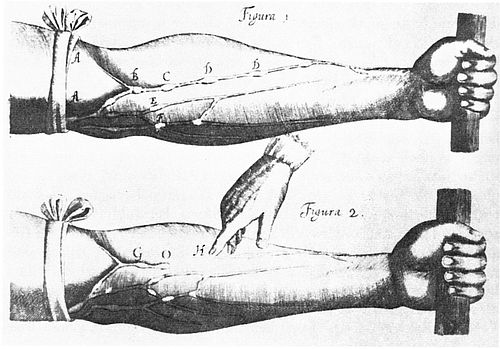
Consequences & Legacy
Harvey's theory of circulation was rejected by many traditionalists at first; the heart was, after all, still considered by many to be the very soul of a human, that secret compartment where love, passion, goodness, and sin resided. The idea that the heart was simply a mechanical-like device for pumping blood around the body was shattering to two millennia of scientific, religious, and artistic thought. Members of the London College of Physicians baulked at the idea of overturning Galen's long-established theories. Harvey even lost a few of his own private patients who considered his 'discovery' evidence that the physician's judgement was no longer to be trusted.
Nevertheless, the theory found its supporters over the next two decades. Harvey himself aided its acceptance through letters to prominent academics, new essays, and several public demonstrations. Gradually, the theory was accepted by the wider scientific community. There were even enthusiastic supporters in other fields such as philosophy (notably, but with some alteration, René Descartes) and astrology. In the literary world (Daniel Defoe was an admirer of Harvey's work, for example), Harvey's analogy of the human heart governing the welfare of the body like a monarch or parliament governing a state was appreciated. With the English Civil Wars (1641-1652) just around the corner, the theory seemed fit for the times.
Crucially, Harvey's theory of circulation was further confirmed by new discoveries, such as in 1661 when the presence of capillaries between the veins and arteries was discovered by Marcello Malpighi (1628-1694) using a microscope. There still remained the problem of determining just why the blood was circulated around the body. Further examination of the heart muscles by such figures as Richard Lower (1631-1691) refined Harvey's theory with the hypothesis that the blood is oxygenated (i.e. transformed from venous to arterial blood) in the lungs and not the heart. Harvey, unaware of the function of gills (like everyone else at the time), was led down the wrong path into thinking the lungs were immaterial to circulation when he noted that fish had a perfectly functioning circulatory system but no lungs. Measures of the pressure and flow of circulated blood were taken by Stephen Hales (1677-1761), which added to an ever-clearer picture of just how and why the circulation system works as it does.
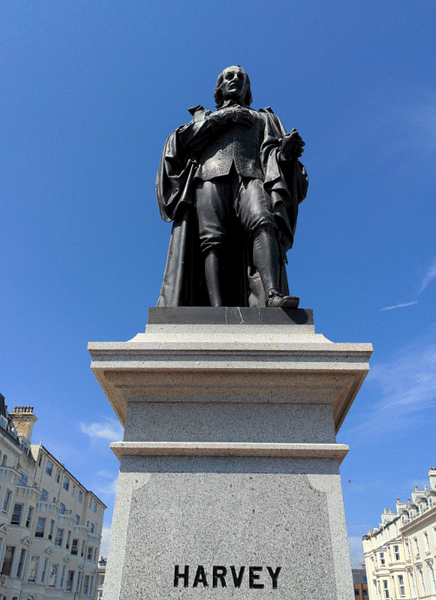
There were two other, longer-term consequences to Harvey's discovery of the blood's circulation. The first significant consequence was the importance Harvey had given to experimentation and the accumulation of evidence to support his scientific theory. This approach became standard practice in science thereafter. As the historian W. Burns puts it:
As one of the first major innovations in natural philosophy to be put forth and accepted largely on the basis of experimental evidence, Harvey's theory of circulation helped create the prestige of experiment and experimental science in the seventeenth century. (Burns, 131).
The second significant consequence of Harvey's discovery and the importance of blood circulation was that "many 18th-century authors attributed to it alone all the properties formerly associated with the other humours" (Bynum, 45). It was not until the end of the 18th century that scientists began to take an interest in what exactly were the components of blood. Harvey, meanwhile, reserved his latter years for the study of embryos.
When scientists again turned their focus to the mysteries of blood, Harvey's now well-established discovery presented a new range of possibilities for scientific inquiry such as how a patient might suffer from deficiencies of certain substances in the blood, and, conversely, how they might benefit from additions to their circulation made via injections and transfusions. In short, a whole new field of medical science was opened up, one which continues to extend its frontiers of knowledge today.

